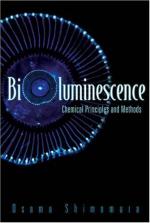|
This section contains 562 words (approx. 2 pages at 300 words per page) |

|
Bioluminescence refers to the light-emitting characteristics of certain living organisms. It is a special type of the more general process, chemiluminescence that relates to the production of light from a chemical reaction. The reaction that creates bioluminescence is generally the same in all organisms. It is a complex one that involves the oxidation of luciferin (a protein) catalyzed by luciferase enzyme.
A wide variety of organisms throughout nature produce light. The most familiar are fireflies and glow worms. However, bioluminescence is more commonly found in marine animals such as jellyfish, dinoflagellates, mollusks, shrimp, octopuses, fish, and sponges. Bacteria and fungi also have species that exhibit bioluminescence. These organisms create bioluminescence in many ways and for different reasons. Fireflies have glowing abdomens, which function in mating. Marine fireworms use bioluminescence for a similar reason. Deep sea fish have organs called photophores which create a center for the bioluminescent reactions...
|
This section contains 562 words (approx. 2 pages at 300 words per page) |

|


